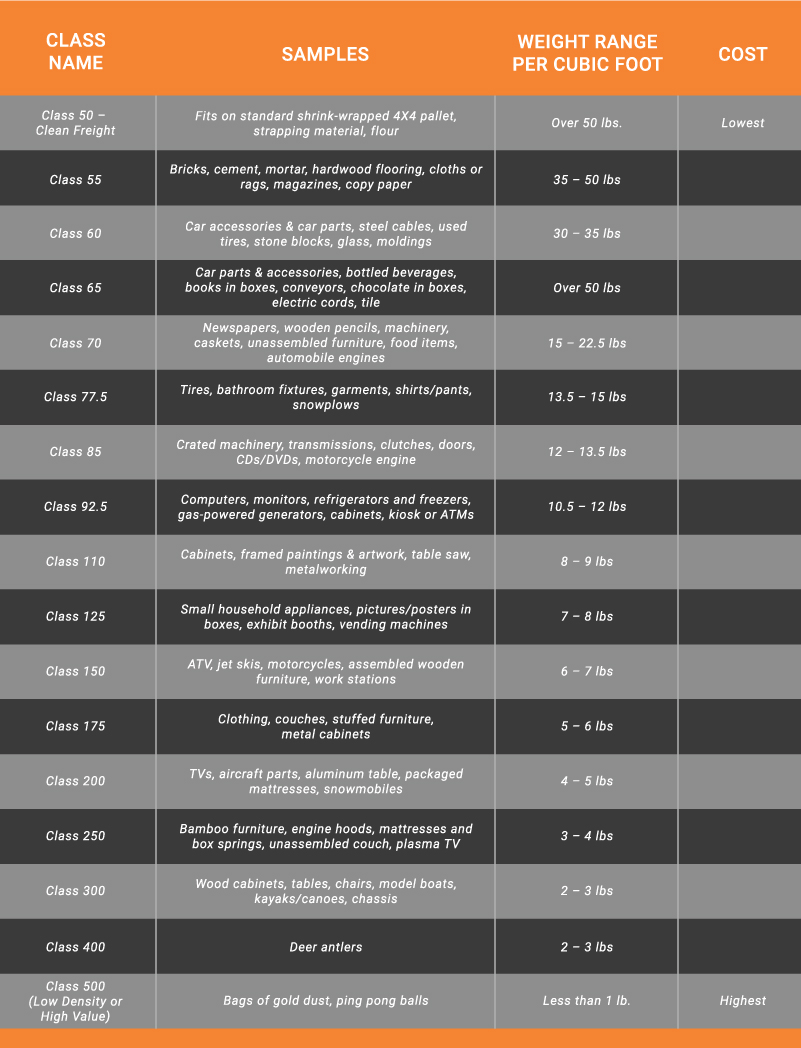Did you know that the LTL (Less Than Truckload) industry, along with the railroad freight industry, are the only shipping sectors that use a freight classification system? In 1983, the National Motor Freight Classification (NMFC) was created to classify railroad shipments in the US. The system, now regulated by the National Motor Freight Traffic Association, was eventually adopted by the LTL industry to categorize goods and accurately determine shipping prices.

How is Freight Class Determined?
With NMFC, shipments are grouped into one of 18 classes - from a low of class 50 to a high of class 500. Goods assigned to class 50 are the least costly to ship, while those assigned to class 500 are the most costly.
An item’s class is specifically determined by four individual characteristics: density, handling, stowability, and liability. In short, the less a carrier has to worry about the freight, the lower the expense of shipping. Let’s delve into the four individual characteristics that determine freight class.
- Density is defined as the pounds per cubic feet of your shipment. Higher density normally means a lower freight class.
- Handling focuses on the ease or difficulty of handling between terminals. Fragility of the item is taken into consideration.
- Stowability refers to how challenging the freight will be to ship in relation to other goods. One example of this is hazardous items, which must be shipped separately from non-hazardous items. Another example of are goods with uncommon dimensions that may not fit efficiently with surrounding freight.
- Liability is based on the probability that the shipment will be lost or damaged and the likelihood that it will damage surrounding freight.
Though the density, handling, stowability, and liability are the main class determinations, there are other things to take into consideration. For example, there are certain fixed class items like vehicle transmissions that have a permanent class, regardless of size and weight.
What Are the Specific Freight Classes?
Before being shipped, each item or pallet in a shipment must be coded with a corresponding class number from the NMFC database and recorded on the Bill of Lading (BOL).
The classes are as follows:

Finding the Correct Freight Class
It's important that the shipper assigns the correct class number and labels the BOL accordingly.
Be aware that classifications are subject to change by the NMFTA. This often happens as a response to fluctuating markets and can leave shippers confused about the total cost of their shipment. To help determine your shipment’s current freight class, you can enter its dimensions and weight into FedEx’s Freight Class and Density Calculator, which features up-to-date classification information.
What Can Happen if the Freight Class Isn’t Correct?
The shipper must record the goods with the correct NMFC number on a Bill of Lading before the carrier leaves with the shipment. Major issues can occur when the wrong class in noted on the BOL, including:
- The freight may be unsuited for the carrier’s storage capacity, weight limits, and specific equipment, which can lead to fines and more.
- The carrier may choose to correct the classification, leading to inconsistency on the invoice.
- The freight may be subject to increased scrutiny. Inspections are more common when the incorrect NMFC number is listed or no number is listed at all.
- The shipper ends up paying more than they need to for the shipment.
- The misclassified freight may not be handled as it should be, leading financial loss, damage, or even unhappy customers.
- Ultimately, disputes over classification can be complex, expensive, and time consuming.
Freight Class Tips and Tricks
Below are some ways shippers can apply their freight class knowledge to create a much smoother, more efficient shipping process.
- Class calculators are useful and can provide the density of a shipment, but the assigned classes are only estimates. Remember that not all items have density-based classes.
- Include the freight description on the BOL to the best of your ability. An unspecific label is much more likely to be re-classed since the carrier doesn’t have a clear idea of what the freight is and therefore no idea which class is correct.
- Always be truthful. Fight the urge to cheat or “fudge the numbers” when filling out your Bill of Lading. In the long run, shippers who are dishonest always end up paying for it with penalties for frequent re-classifications.
- Be knowledgeable about your carriers. All carriers do not have the exact same procedures and some are harder on re-classes and inspections than others. Be aware of your carriers’ protocols.
- As mentioned above, always include the correct NFMC code on the Bill of Lading so the carrier can see it. New electric Bill of Lading technology greatly reduces inaccuracies and creates efficiencies throughout the shipping process.
Understanding and properly noting freight class is an essential step in becoming a successful shipper. Knowing where to go for information and how to utilize is key for a smooth, worry-free shipping process. Looking for more help with accurately determining freight class for your shipment? Contact us and we'd be happy to help!
.png)
.png)
.png)